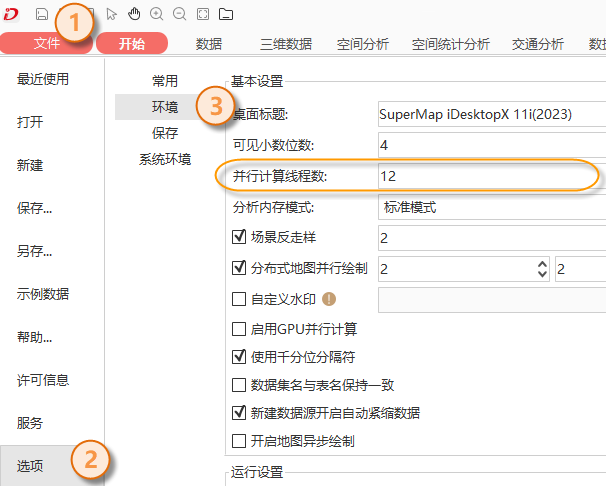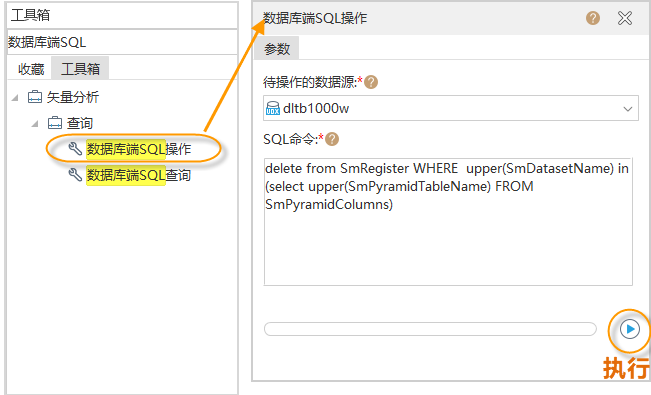Feature Description
The Create Vector Pyramid tool generates vector pyramids for SuperMap vector datasets.
Problems Addressed by Vector Pyramid
Vector pyramids significantly improve display efficiency for massive vector data at small scales, enabling second-level map browsing responses. For example: After creating a vector pyramid for tens of millions of land parcel data, full-display performance improves 10-fold, with only ~140,000 simplified objects rendered and correct visual effects maintained.
When creating a vector pyramid, the original dataset serves as the most detailed base level. The system generates multiple simplified sub-datasets at different pyramid levels using specific rules and algorithms. Smaller pyramid levels represent higher simplification degrees. During map display, appropriate pyramid levels are selected based on scale - smaller scales display more simplified data, greatly enhancing rendering efficiency.
Simplification algorithms follow this principle: As scale decreases, tiny objects become imperceptible, and complex line/contour details become indistinguishable. The algorithm removes imperceptible objects and simplifies lines while preserving visual correctness.
Notes on Data and Pyramid Levels
Supported Data Types: Point/Line/Polygon datasets in UDBX, PostGIS, and Yukon datasources.
Resource Considerations: Vector pyramid creation consumes significant time and computational resources. Generally recommended for datasets exceeding millions of records requiring smooth small-scale browsing.
Level Configuration:
- Higher levels mean less simplification but longer creation time.
- Levels above 12 typically don't improve display efficiency for large-scale data (e.g., scales larger than level 12). For slow large-scale display:
- Rebuild spatial indexes if missing
- Enable "Simplified Display" for PostGIS datasets (in dataset properties)
Table 1 shows pyramid level-scale relationships and corresponding resolutions. Simplification resolution = Level Resolution × Resolution Factor. Higher resolution factors increase simplification but may cause distortion (default=0.75, ≥0.5 recommended).
Table 1: Vector Pyramid Level-Scale Relationships and Resolutions by Coordinate System
| Level | Scale | Resolution (Degree) (EPSG 4326) | Resolution (Meter) (EPSG 3857) |
|---|---|---|---|
| 0 | 1:295,829,355.455 | 0.703125000000 | 78271.516964020500 |
| 1 | 1:147,914,677.727 | 0.351562500000 | 39135.758482010200 |
| 2 | 1:73,957,338.864 | 0.175781250000 | 19567.879241005100 |
| 3 | 1:36,978,669.432 | 0.087890625000 | 9783.939620502560 |
| 4 | 1:18,489,334.716 | 0.043945312500 | 4891.969810251280 |
| 5 | 1:9,244,667.358 | 0.021972656250 | 2445.984905125640 |
| 6 | 1:4,622,333.679 | 0.010986328125 | 1222.992452562820 |
| 7 | 1:2,311,166.839 | 0.005493164063 | 611.496226281410 |
| 8 | 1:1,155,583.42 | 0.002746582031 | 305.748113140705 |
| 9 | 1:577,791.71 | 0.001373291016 | 152.874056570353 |
| 10 | 1:288,895.855 | 0.000686645508 | 76.437028285176 |
| 11 | 1:144,447.927 | 0.000343322754 | 38.218514142588 |
| 12 | 1:72,223.964 | 0.000171661377 | 19.109257071294 |
| 13 | 1:36,111.982 | 0.000085830688 | 9.554628535647 |
| 14 | 1:18,055.991 | 0.000042915344 | 4.777314267824 |
| 15 | 1:9,027.995 | 0.000021457672 | 2.388657133912 |
| 16 | 1:4,513.998 | 0.000010728836 | 1.194328566956 |
| 17 | 1:2,256.999 | 0.000005364418 | 0.597164283478 |
| 18 | 1:1,128.499 | 0.000002682209 | 0.298582141739 |
| 19 | 1:564.2495 | 0.000001341105 | 0.149291070869 |
| 20 | 1:282.12475 | 0.000000670552 | 0.074645535435 |
| 21 | 1:141.062375 | 0.000000335276 | 0.037322767717 |
| 22 | 1:70.5311875 | 0.000000167638 | 0.018661383859 |
Parameter Description
| Parameter | Description | Type |
|---|---|---|
| Source Datasource | Datasource containing input dataset. | Datasource |
| Source Dataset | Target vector dataset for pyramid creation. Supports UDBX/PostGIS/Yukon point/line/polygon datasets. |
DatasetVector |
| Min Level | Minimum pyramid level (default=0). | Integer |
| Max Level | Maximum pyramid level (default=11). Higher levels increase creation time. | Integer |
| Increment | Level interval (default=1). Values ∈ {1,2,3,4}. | Integer |
| Resolution Factor | Simplification resolution = Level Resolution × this factor. Higher values improve performance but reduce accuracy (default=0.75, ≥0.5). |
Double |
| Creation Method | Simplification algorithm: - Topological Method: Higher simplification, more resource-intensive, better display performance. - Grid Method: Faster creation, lower simplification (default=Topological). |
String |
| Separate Storage | Store pyramid in "sdx" schema (✓) or source dataset's schema (☐). | Boolean |
| Rebuild Pyramid | Recreate pyramid if exists (✓). Keep existing if ☐. | Boolean |
This tool supports multithreading. In iDesktopX, set thread count via: File > Options > Environment > Parallel Computing Threads.

Output
The output is the input vector dataset with generated pyramid structure.
Cartography
Vector pyramids support thematic mapping for massive datasets. However, pyramid layers only retain smid and smgeometry fields by default. To optimize thematic mapping:
Use the Copy Fields to Vector Pyramid tool to add required fields to pyramid layers, avoiding slow field retrieval from original data.
Copy Fields to Vector Pyramid Tool Parameters
| Parameter | Default | Description | Type |
|---|---|---|---|
| Dataset | Vector dataset with pyramid. Use "Open Dataset" tool as input. |
DatasetVector | |
| Field Names | Fields to copy (multiple supported). | String |
Compatibility Notes
Vector pyramids generate simplified sub-datasets associated with the original. In iDesktopX 11.1.0+, pyramid layers are hidden. Lower versions display them as regular datasets. To correct this:
Use Database-side SQL Operation Tool:
- Target Datasource: UDBX/PostGIS datasource with pyramid data
- SQL Command:
DELETE FROM SmRegister WHERE upper(SmDatasetName) IN (SELECT upper(SmPyramidTableName) FROM SmPyramidColumns)
Execute to unregister pyramid layers as regular datasets.




